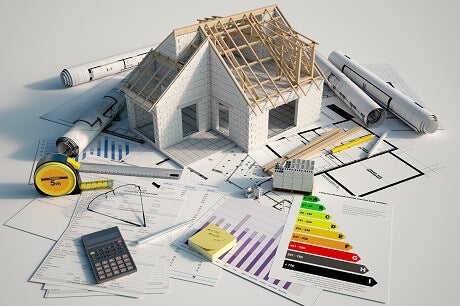Blog

How to save energy and money in your home
Posted on 13 April 2022 in Blog
Saving energy in your home is a great way to keep more money in your pocket and is better for the environment. With energy now so expensive, its extra important to keep that heat inside your home. Your also then doing your bit to reduce your carbon footprint and help towards our net zero goals.
There are plenty of options available for your home that can help save energy. Here are our tips and advice to help you save money and energy heating your home.
Heating
When thinking about how to save energy in your home, heating may well be one of the first things you think of. Heating our homes and places of work accounts for around a fifth of the UK’s total emissions so finding ways to be as efficient as possible is a great way to tackle climate change.
When thinking about the way you heat your home it’s important to not only think of how you produce heat in the first place, but also how you keep the heat inside your home. See how we break it down below.
Insulation and Draught Proofing
Having an efficient heat source is great for keeping energy usage down in your home, more importantly though is ensuring that the heat isn’t escaping. Keeping heat in the home means you will need a smaller amount of heat to warm up the home in the first place, saving you money over the course of a year.
Heating a home becomes a lot more expensive and inefficient when most of the heat is escaping through the roof, windows or walls. Consider loft insulation, wall insulation and double or triple glazing.
Draught proofing your home is also one of the cheapest and most effective ways to save money and energy in any type of building. To draught proof your home, you should block up unwanted gaps that let in cold air and let out the warm air. This can be done professionally or via DIY.
Here are some handy DIY draught proofing solutions for you:
- For Windows that open, buy draught-proofing strips to stick around the window frame and fill the gap between the window and the frame.
- For Doors, there are a few changes that you can make, firstly the Keyhole – buy a purpose-made cover that drops a metal disc over the keyhole. For the letterbox – use a letterbox flap or brush, but remember to measure your letterbox before you buy. The Gap at the bottom – use a brush or hinged flap draught excluder and finally the gaps around the edges – fit foam, brush or wiper strips like those used for windows.
- For floorboards and skirting boards, you can block cracks in your floor by squirting filler into the gaps. Floorboards and skirting boards often contract, expand or move slightly with everyday use, so you should use a filler that can tolerate movement – these are usually silicone-based.
Heating systems
Inefficient heating systems are the main causes of higher heating and energy bills in households, with heating energy accounting for around 50% of all the energy used in the home. Currently, gas boilers are the most common form of heating in a home but an awful lot of them are oversized and aren’t working properly. If you have a condensing gas boiler, please check if it is actually condensing! In simple terms you want the flow temperature no more that 55°c. It’s often the case that they are set high (by being poorly commissioned) and will be far less efficient than they could be.
Of course if you are looking to more sustainable solutions heat pumps are finally are becoming more well known as perfect alternatives to fossil fuel boilers that can effectively heat all types of buildings. Heat pumps are a proven technology across Europe and are most popular in Sweden!
Heat pumps are the most efficient and eco-friendly ways to heat a home. They work by extracting heat from the air or ground, converting it into heating for your home and hot water. Where gas boilers at best operate at around 92% efficiency (they are often not running anywhere near this), heat pumps can reach up to 400% which means lower running costs and lower emissions all-round.
The upfront costs of heat pumps can be off-putting for some, but the financial gains in the long run offset this initial cost. There are also government incentives available to help cover the cost, such as the Boiler Upgrade Scheme (BUS). Heat pumps will be vital for the future of homes as part of the Government’s ‘green revolution’ and provides a huge benefit to homes.
Find out more about the types of Heat Pumps available, and how Thermal Earth can help you decide on what option is right for you.
Solar thermal panels are an effective way to provide your hot water whilst saving energy. They convert energy from the sun into heat by warming fluid within the panels. Solar thermal panels can produce up to 60% of your home’s annual hot water, and up to 100% in the summer months. Not only does this help you to save energy but it can also lower your energy bills.
Tips to save extra heat energy in your home
Master your thermostat and heating controls – keeping a fairly constant room temperature
The most effective heat pump systems utilise weather compensation. What this means is increasing the water temperatures in your heating system when it’s cold and decreasing it when its warmer. With this, we recommend to keep room temperatures fairly constant with minimum set back temperatures to maximise your comfort and operational efficiency.
Utilising our systems and our intelligent controls, we guarantee maximum comfort and performance all year around.
Reduce the maximum temperature
During cold weather it feels like you might need to crank the heating up to compensate for frozen fingers and toes when you’ve been out and about, however think twice before you set the temperature to the max. Knocking the temperature of your heating down by just 1°C could cut up to 10% off your energy use per year, and you are unlikely to notice the difference!
If you’re ready to make the change to becoming more energy efficient in your home and want to make the change towards renewable and low temperature heating, get in touch to see how we can help.
 Facebook
Facebook LinkedIn
LinkedIn Twitter
Twitter













